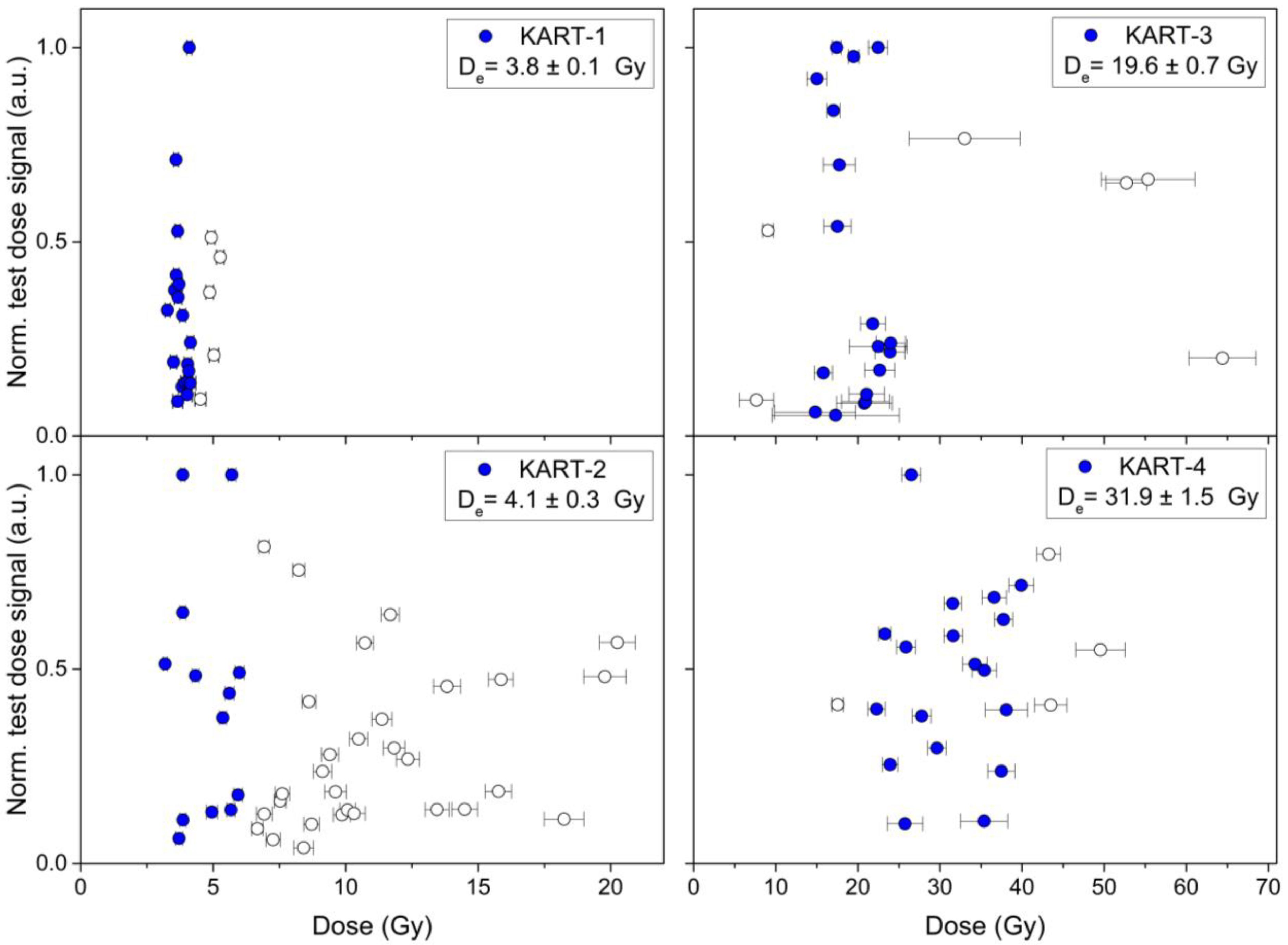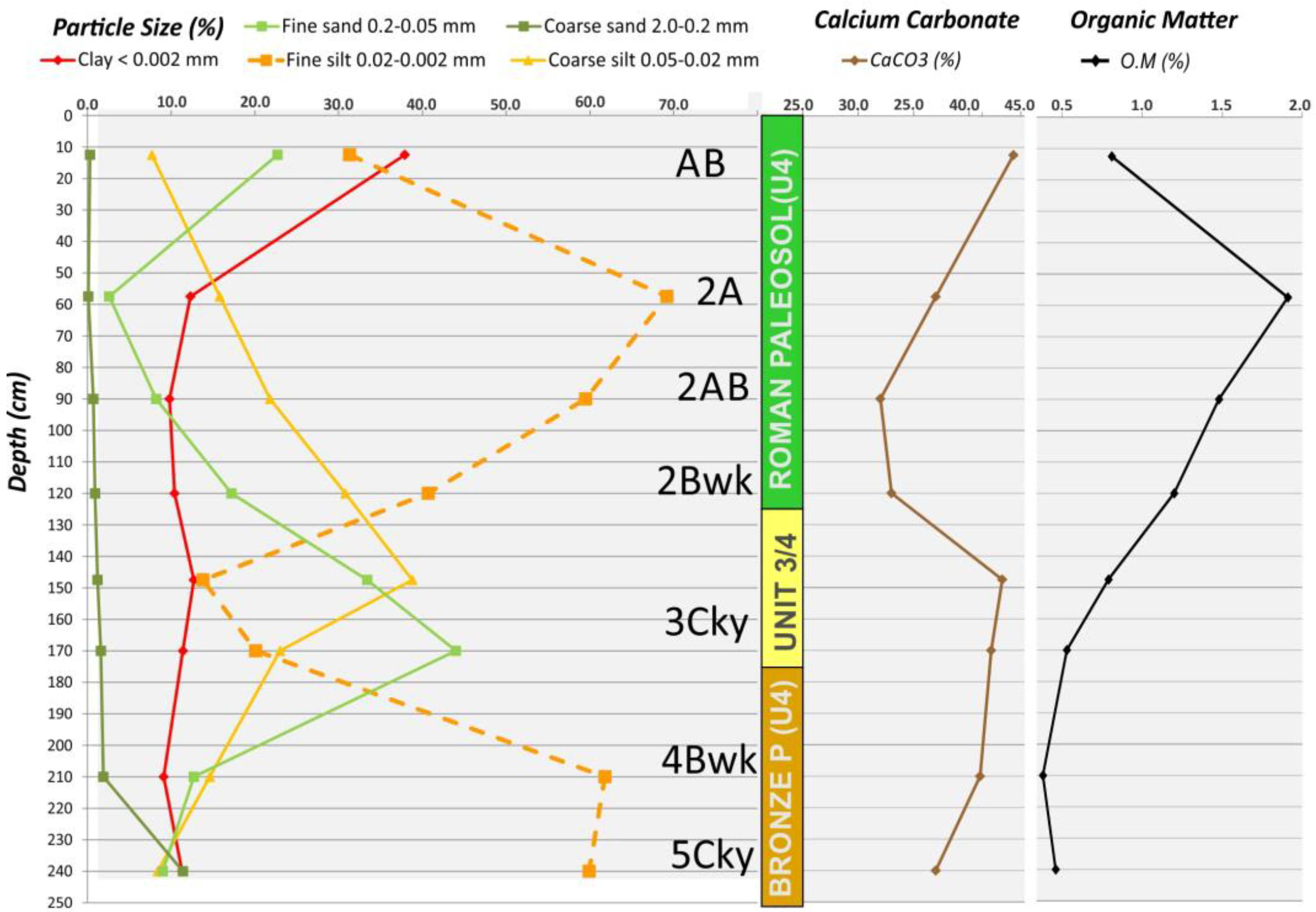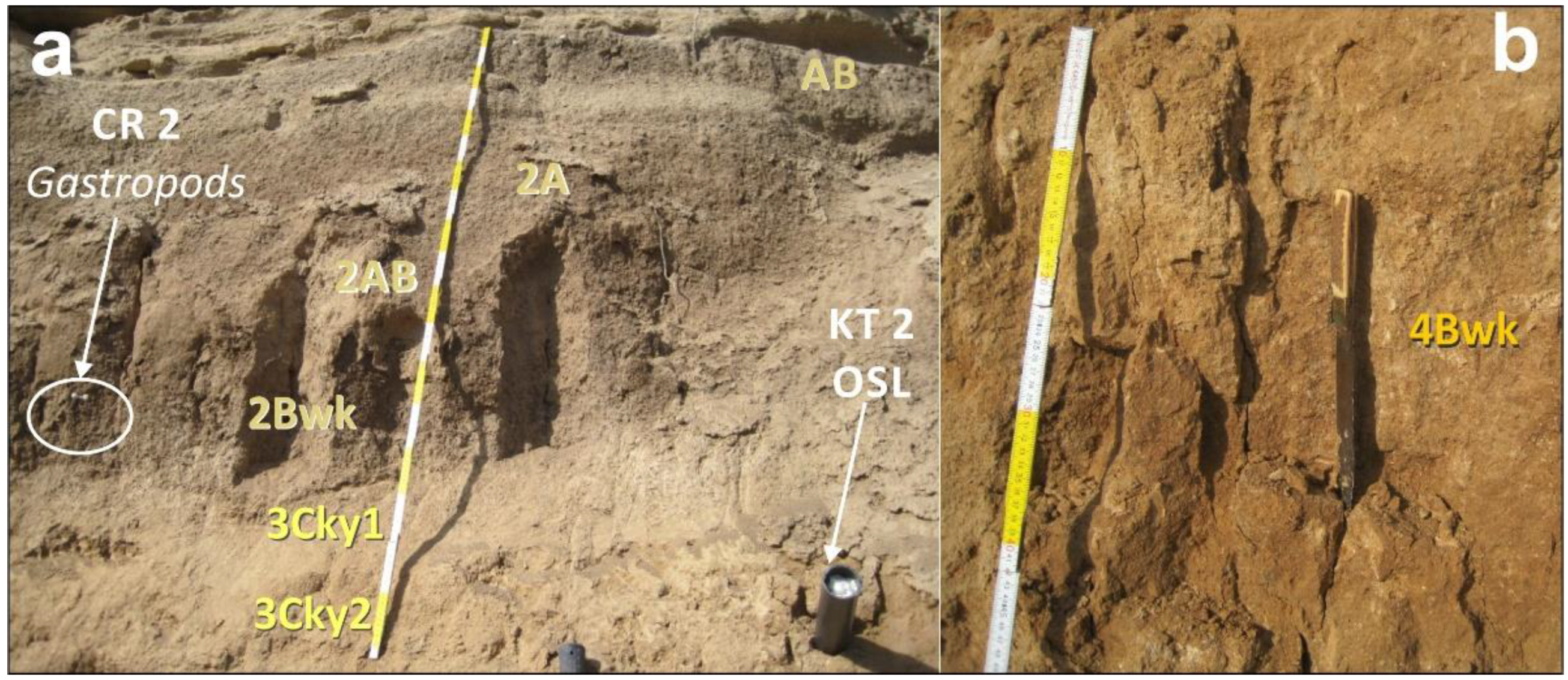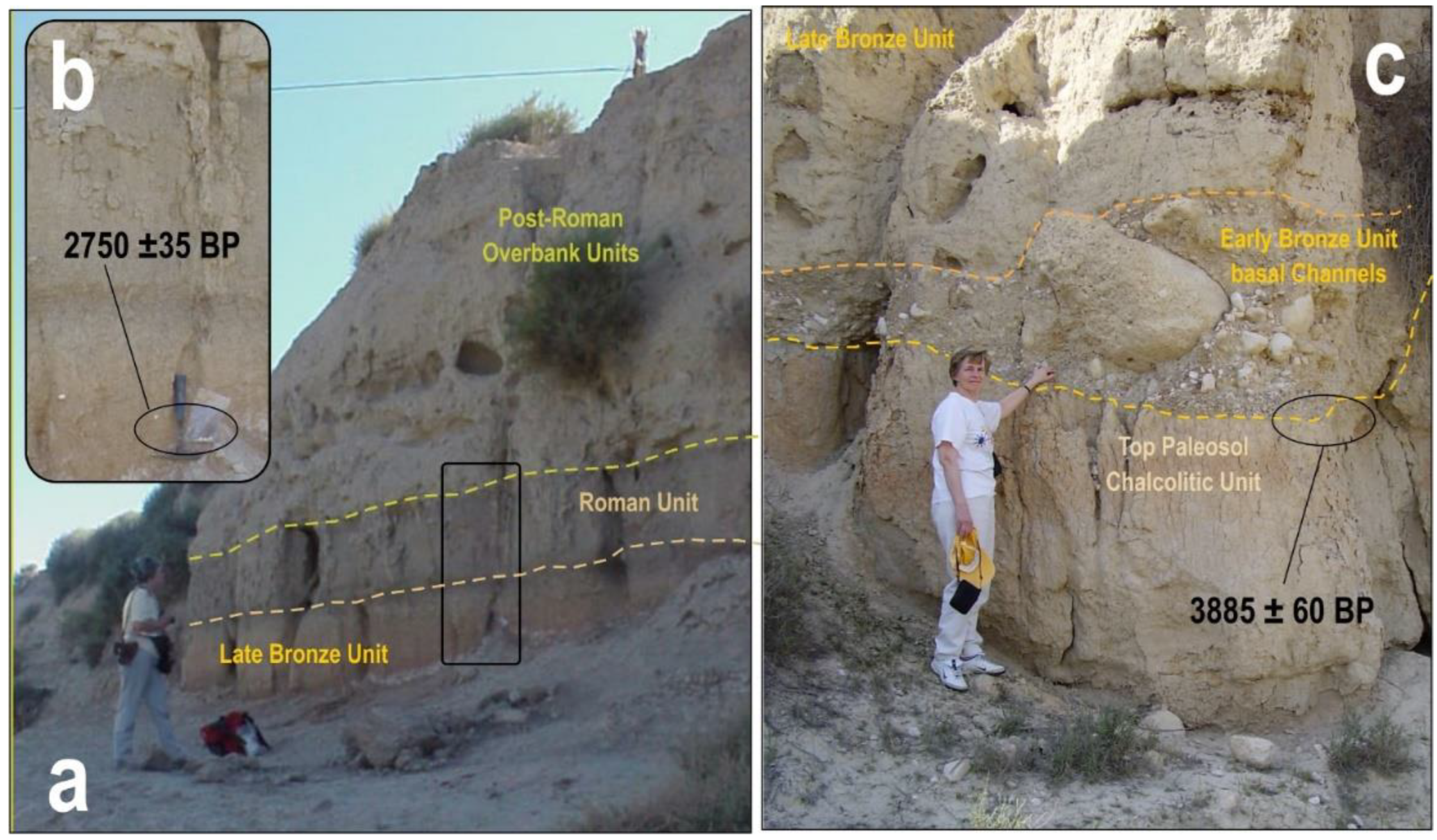Dating of Holocene Sedimentary and Paleosol Sequence within the Guadalentín Depression (Murcia, SE Spain): Paleoclimatic Implications and Paleoseismic Signals
Abstract
:1. Introduction
2. Geological and Geomorphological Frameworks
3. Materials and Methods
3.1. Radiocarbon Dating (14C)
3.2. Optically Stimulated Luminescence Dating (OSL)
3.3. Analysis of Paleosols
4. The Holocene Sequence of the Karting Espuña Section: Sedimentology and Chronology
4.1. Sedimentological and Stratigraphic Features
4.2. Geochronological Analysis
5. The Paleosol Profile of the Karting Espuña Sequence
6. Discussion
6.1. Environmental Significance of the Late Bronze Paleosol
6.2. Environmental Significance of the Calcolithic Paleosol
6.3. Environmental Significance of the Roman Period Paleosol
6.4. The Post-Roman Environmental Evolution
6.5. Paleoseismic Evidence of Earthquakes Holocene Sedimentary Sequence
7. Conclusions
Author Contributions
Funding
Institutional Review Board Statement
Informed Consent Statement
Data Availability Statement
Acknowledgments
Conflicts of Interest
References
- Silva, P.G.; Goy, J.L.; Somoza, L.; Zazo, C.; Bardají, T. Landscape response to strike-slip faulting linked to collisional settings: Quaternary tectonics and basin formation in the Eastern Betics, southeast Spain. Tectonophysics 1993, 224, 289–303. [Google Scholar] [CrossRef]
- Silva, P.G.; Harvey, A.M.; Goy, J.L.; Zazo, C. Geomorphology, depositional style and Morphometric relationships of Quaternary alluvial fans in the Guadalentín Depression (Murcia, SE Spain). Z. Für Geomorphol. 1992, 36, 325–341. [Google Scholar] [CrossRef]
- Silva, P.G. The Guadalentín Tectonic Depression, Betic Cordillera, Murcia. In Landscapes and Landforms of Spain; Gutiérrez, F., Gutiérrez, M., Eds.; World Geomorphological Landscapes Series; Springer: Dordrecht, The Netherlands, 2014; pp. 25–35. [Google Scholar] [CrossRef]
- Calmel-Ávila, M.; Silva, P.G.; Bardají, T.; Goy, J.L.; Zazo, C. Drainage system inversion in the Guadalentín Depression during the late Pleistocene–Holocene (Murcia, Spain). In Advances in Studies of Desertification; Romero, C., López Bermúdez, F., Eds.; Serv. Pub. Univ.: Murcia, Spain, 2009; pp. 461–464. [Google Scholar]
- Calmel-Ávila, M. The Librilla “rambla” an example of morphogenetic crisis in the Holocene (Murcia, SE Spain). Quat. Int. 2002, 93–94, 101–108. [Google Scholar] [CrossRef]
- Silva, P.G.; Bardají, T.; Calmel-Ávila, M.; Goy, J.L.; Zazo, C. Transition from alluvial to fluvial systems in the Guadalentín Depression (SE Spain) during the Holocene: Lorca Fan versus Guadalentín River. Geomorphology 2008, 100, 140–153. [Google Scholar] [CrossRef]
- Calmel-Ávila, M. Procesos hídricos holocenos en el Bajo Guadalentín (Murcia, España). Cuatern. Y Geomorfol. 2000, 14, 65–78. [Google Scholar]
- Calmel-Ávila, M. Étude des paléoenvironnements holocènes dans le bassin du Bas-Guadalentín (Région de Murcie, Espagne). Géomorphologie 2000, 3, 147–160. [Google Scholar] [CrossRef]
- Silva, P.G.; Goy, J.L.; Zazo, C.; Bardají, T. Evolución reciente del drenaje en la Depresión del Guadalentín (Murcia). Geogaceta 1996, 20, 1385–1389. [Google Scholar]
- Harvey, A.M. Factors influencing Quaternary alluvial fan development in Southeast Spain. In Alluvial Fans: A Field Approach; Rachocki, A.H.J., Church, U., Eds.; John Wiley & Sons: New York, NY, USA, 1990; pp. 247–269. [Google Scholar]
- Páez Blázquez, M. La influencia de la gestión de las aguas en los criptohumedales de la región de Murcia: Saladares del Guadalentín y Ajauque-Rambla Salada. In Conflictos Entre el Desarrollo de las Aguas Subterráneas y la Conservación de los Humedales del Litoral Mediterráneo; Fundación M. Botín: Madrid, Spain, 2003; pp. 253–280. [Google Scholar]
- Silva, P.G.; Roquero, E.; Rodríguez-Pascua, M.A.; Bardají, T.; Giner, J.; Perucha, A.; Élez, J. Record of a Roman Earthquake (2nd Century AD) in the Guadalentín Depression (Murcia, SE Spain): Micro-morphological analysis of liquefaction. Geotemas 2016, 16, 391–394. [Google Scholar]
- Roquero, E.; Silva, P.G.; Élez, J.; Rodríguez-Pascua, M.A.; Medialdea, A. Registro edáfico de los cambios paleoambientales en la Depresión del Guadalentín durante el Holoceno (Murcia, SE España). In Actas XV Reunión Nacional de Cuaternario AEQUA; Universtiy of Vasque Country UPV-EHU: Bilbao, Spain, 2019; pp. 235–237. [Google Scholar]
- Silva, P.G.; Roquero, E.; Bardají, T.; Medialdea, A. Pleistocene to Holocene phases of sedimentation and soil formation in the semiarid SE Spain (Eastern Betic Cordillera). Cuatern. Y Geomorfol. 2020, 34, 41–61. [Google Scholar] [CrossRef]
- Silva, P.G.; Roquero, E.; Élez, J.; Bardají, T. Medialdea. Phases of sedimentation and soil formation in SE Spain during the Holocene (Eastern Betic Cordillera). Geotemas 2021, 18, 1027–1030. [Google Scholar]
- Rodríguez-Lloveras, X.; Machado, M.J.; Sánchez-Moya, Y.; Celleb, M.; Medialdea, A.; Sopeña, A.; Benito, G. Impacts of sediment connectivity on Holocene alluvial records across a Mediterranean basin (Guadalentín River, SE-Spain). Catena 2020, 187, 104321. [Google Scholar] [CrossRef]
- Insua, J.M.; García-Mayordomo, J.; Salazar, A.; Rodríguez-Escudero, E.; Martín-Banda, R.; Álvarez-Gómez, J.A.; Canora, C.; Martínez-Díaz, J.J. Paleoseismological evidence of Holocene activity of the Los Tollos Fault (Murcia, SE Spain): A lately formed Quaternary tectonic feature of the Eastern Betic Shear Zone. J. Iber. Geol. 2015, 41, 333–350. [Google Scholar] [CrossRef] [Green Version]
- Ferrater, M.; Silva, P.G.; Ortuño, M.; Rodríguez-Pascua, M.A.; Masana, E. Archaeoseismologic analysis of a Late Bronze Age site on the Alhama de Murcia Fault: La Tira del Lienzo (Murcia, SE Spain). Geoarchaeology 2015, 30, 151–165. [Google Scholar] [CrossRef]
- Bronk Ramsey, C. Bayesian analysis of radiocarbon dates. Radiocarbon 2009, 51, 337–360. [Google Scholar] [CrossRef] [Green Version]
- Reimer, P.; Bard, E.; Bayliss, A.; Beck, J.; Blackwell, P.; Ramsey, C.; Van der Plicht, J. IntCal13 and Marine13 Radiocarbon Age Calibration Curves 0–50,000 years cal BP. Radiocarbon 2013, 55, 1869–1887. [Google Scholar] [CrossRef] [Green Version]
- Roquero, E.; Silva, P.G.; Rodríguez-Pascua, M.A.; Giner-Robles, J.L.; Élez, J.; Perucha, M.A. Micromorphology of seismic liquefaction structures: A tool to record lost seismic events (Betic Cordillera, Spain). In Actas III Reunión Ibérica sobre Fallas Activas; IBERFAULT 3: Alicante, Spain, 2018; pp. 195–198. [Google Scholar]
- Aitken, M.J. Introduction to Optical Dating; Oxford University Press: Oxford, UK, 1998. [Google Scholar]
- Guérin, G.; Mercier, N.G.; Adamiec, G. Dose-rate conversion factors: Update. Anc. TL 2011, 29, 5–8. [Google Scholar]
- Prescott, J.R.; Hutton, J.T. Cosmic ray contributions to dose rates for luminescence and ESR dating: Large depths and long term time variations. Radiat. Meas. 1994, 23, 497–500. [Google Scholar] [CrossRef]
- Durcan, J.; King, G.; Duller, G.A.T. DRAC: Dose Rate and Age Calculator for trapped charge dating. Quat. Geochronol. 2015, 28, 54–61. [Google Scholar] [CrossRef] [Green Version]
- Murray, A.S.; Wintle, A.G. Luminescence dating of quartz using an improved single-aliquot regenerative-dose protocol. Radiat. Meas. 2000, 32, 57–73. [Google Scholar] [CrossRef]
- Galbraith, R.F.; Roberts, R.G.; Laslett, G.M.; Yoshida, H.; Olley, J.M. Optical dating of single and multiple grains of quartz from Jinmium rock shelter, Northern Australia: Part 1, experimental design and statistical models. Archaeometry 1999, 41, 339–364. [Google Scholar] [CrossRef]
- Thomsen, K.J.; Murray, A.S.; Bøtter-Jensen, L. Sources of variability in OSL dose measurements using single grains of quartz. Radiat. Meas. 2005, 39, 47–61. [Google Scholar] [CrossRef]
- Benito, G.; Rico, M.; Sánchez-Moya, Y.; Sopeña, A.; Thorndycraft, V.R.; Barriendos, M. The impact of late Holocene climatic variability and land use change on the flood hydrology of the Guadalentín River, southeast Spain. Glob. Planet. Change 2010, 70, 53–63. [Google Scholar] [CrossRef] [Green Version]
- Medialdea, A.; Thomsen, K.J.; Murray, A.S.; Benito, G. Reliability of equivalent-dose determination and age-models in the OSL dating of historical and modern palaeoflood sediments. Quat. Geochronol. 2014, 22, 11–24. [Google Scholar] [CrossRef] [Green Version]
- FAO Guideline for Soil Description, 4th ed.; Soil Resources, Management and Conservation Service, Land and Water Development Division FAO: Rome, Italy, 2006; 97p, Available online: http://refhub.elsevier.com/S0169-555X(19)30250-8/rf0050 (accessed on 1 May 2022).
- Soil Survey Staff. Keys to Soil Taxonomy, 12th ed.; USDA-Natural Resources Conservation Service: Washington, DC, USA, 2014; 360p.
- Munsell Soil Color Chart; Munsell Color Company, Macbeth Division of Kollmorgen: Baltimore, MD, USA, 1990; 50p.
- USDA Soil Survey Laboratory Methods; Soil Survey Laboratory Investigations Report No. 42; USDA-Natural Resources Conservation Service: Washington, DC, USA, 2014; 1001p, Available online: http://refhub.elsevier.com/S0169-555X(19)30250-8/rf0180 (accessed on 5 August 2022).
- Standard Test Method for Particle-Size Analysis of Soils D 422-63 (1972); Annual Book of ASTM Standards 04.08:117-127; American Society for Testing Materials: Philadelphia, PA, USA, 1985.
- Woodward, L. A manometric method for the rapid determination of lime in soils. Soil Sci. Soc. Am. Proc. 1961, 25, 248–250. [Google Scholar] [CrossRef]
- Walkley, A.; Black, I.A. An examination of the Degtjareff method for determining soil organic matter and a pro-posed modi-fication of the chromic acid titration method. Soil Sci. 1934, 37, 29–38. [Google Scholar] [CrossRef]
- Stoops, G. Guidelines for Analysis and Description of Soil and Regolith Thin Sections, 2nd ed.; Soil Science Society of America: Madison, MD, USA, 2003; 184p. [Google Scholar]
- Alonso Zarza, A.M.; Silva, P.G.; Goy, J.L.; Zazo, C. Fan-surface dynamics, plant-activity and calcrete development: Interactions during ultimate phases of fan evolution in the semiarid SE Spain (Murcia). Geomorphology 1998, 24, 147–167. [Google Scholar] [CrossRef] [Green Version]
- Candy, I.; Black, S. The timing of Quaternary calcrete development in semi-arid southeast Spain: Investigating the role of climate on calcrete genesis. Sediment. Geol. 2009, 218, 6–15. [Google Scholar] [CrossRef]
- Stokes, M.; Nash, D.J.; Harvey, A.M. Calcrete “fossilisation” of alluvial fans in SE Spain: The roles of groundwater, pedogenic processes and fan dynamics in calcrete development. Geomorphology 2007, 85, 63–84. [Google Scholar] [CrossRef]
- Roquero, E.; Silva, P.G.; Rodríguez-Pascua, M.A.; Bardají, T.; Élez, J.; Carrasco-García, P.; Giner-Robles, J.L. Geomorphology and pedology of faulted fan surfaces and paleosols in the Palomares Fault Zone (Betic Cordillera, SE Spain). Geomorphology 2019, 342, 196–209. [Google Scholar] [CrossRef]
- Cuenca Payá, A.; Walker, M.J. Nuevas fechas 14C para el sector de Alicante y Murcia. Trab. Neogeno Y Cuatern. 1977, 6, 309–318. [Google Scholar]
- Cuenca Payá, A.; Walker, M.J. Palaeoclimatic, palaeoenvironmental and anthropic interactions in SE Spanish Holocene prehistory. In Estudios Sobre Geomorfología del Sur de España; López Bermúdez, F., Thornes, J.B., Eds.; Serv. Pub. Univ.: Murcia, Spain, 1986; pp. 59–66. [Google Scholar]
- Lattman, L.H. Calcium carbonate cementation of alluvial fans in southern Nevada. Geol. Soc. Am. Bull. 1973, 84, 3013–3028. [Google Scholar] [CrossRef]
- Calmel-Avila, M. Tectónica activa y firmas morfológicas en el tramo medio de la fosa del río Guadalentín. In Actas XII Reunión Nacional de Cuaternario; Asociación española para el estudio del Cuaternario (AEQUA): Ávila, Spain, 2007; pp. 135–138. [Google Scholar]
- Walker, M.; Head, M.J.; Berkelhammer, M.; Björck, S.; Cheng, H.; Cwynar, L.; Fisher, D.; Gkinis, V.; Long, A.; Lowe, J.; et al. Formal ratification of the subdivision of the Holocene Series/ Epoch (Quaternary System/Period): Two new Global Boundary Stratotype Sections and Points (GSSPs) and three new stages/subseries. Episodes 2018, 41, 213–223. [Google Scholar] [CrossRef] [Green Version]
- Blanco-González, A.; Lillios, K.T.; López-Sáez, J.A.; Drake, B.L. Cultural, Demographic and Environmental Dynamics of the Copper and Early Bronze Age in Iberia (3300-1500 BC): Towards an Interregional Comparison at the Time of the 4.2 ky BP Event. J. World Prehistory 2018, 31, 1–79. [Google Scholar] [CrossRef]
- Aranda Jiménez, G. Resistance and social involution in the Bronze Age communities of southeastern Iberia. Trab. De Prehist. 2015, 72, 126–144. [Google Scholar] [CrossRef] [Green Version]
- Martín-Puertas, C.; Valero-Garcés, B.; Brauer, A.; Mata, M.P.; Delgado-Huertas, A.; Duski, P. The Iberian–Roman Humid Period (2600–1600 cal yr BP) in the Zoñar Lake varve record (Andalucía, southern Spain). Quat. Res. 2009, 71, 108–120. [Google Scholar] [CrossRef]
- Gázquez, F.; Bauska, T.K.; Comas-Bru, L.; Ghaleb, B.; Calaforra, J.M.; Hodel, D.A. The potential of gypsum speleothems for paleoclimatology: Application to the Iberian Roman Humid Period. Sci. Rep. 2020, 10, 14705. [Google Scholar] [CrossRef]
- Martegani, L.; Gázquez, F.; Moreno, A.; Valero-Garcés, B.; Morellón, M.; Bartolomé, M.; Martín-Puertas, C.; Rodríguez-Rodríguez, M. Abrupt lowstands of Laguna de Zoñar (southern Spain) during the Iberian Roman Humid Period recorded by stable isotopes of gypsum hydration water. In EGU General Assembly 2022; EGU22-1370; European Geophysical Union: Vienna, Austria, 2022. [Google Scholar] [CrossRef]
- Castejón Porcel, G.; Romero Díaz, A. Inundaciones en la Región de Murcia en los inicios del Siglo XXI. Rev. Bibliográfica Geogr. Y Cienc. Soc. 2014, 1102, 1–40. [Google Scholar]
- Vita-Finzi, F. The Mediterranean Valleys: Geological Changes in Historical Times; Cambridge University Press: Cambridge, UK, 1969; 207p. [Google Scholar]
- Pocklington, R. Acequias árabes y pre-árabes en Murcia y Lorca: Aportación toponímica a la historia del regadío. In Actes Xè Col·loqui General de la Societat d’Onomàstica: 1er D’onomàstica Valenciana; Universitat de València: Valencia, Spain, 1986; p. 462. [Google Scholar]
- Calmel-Ávila, M. Le petit âge de glace (PAG) dans la vallée du Guadalentín (Sud-Est de l’Espagne, région de Murcie). Mediterráneé 2014, 122, 113–119. [Google Scholar] [CrossRef]
- Balbo, A.L.; Martínez-Fernández, J.; Steve-Selma, M.A. Mediterranean wetlands: Archaeology, ecology, and sustainability. WIREs Water 2017, 4, e1238. [Google Scholar] [CrossRef]
- Martínez-Díaz, J.J.; Masana, E.; Ortuño, M. Active tectonics of the Alhama de Murcia fault, Betic Cordillera, Spain. J. Iber. Geol. 2014, 38, 170–181. [Google Scholar] [CrossRef] [Green Version]
- Silva, P.G.; Pérez-López, R.; Rodríguez-Pascua, M.A.; Roquero, E.; Giner Robles, J.L.; Huerta, P.; Martínez-Graña, A.; Bardají, T. Macroseismic analysis of slope movements triggered by the 2011 Lorca earthquake (Mw 5.1): Application of the ESI-07 scale. Geogaceta 2015, 57, 35–38. [Google Scholar]
- Michetti, A.M.; Esposito, E.; Guerrieri, L.; Porfido, S.; Serva, L.; Tatevossian, R.; Vittori, E.; Audemard, F.; Azuma, T.; Clague, J.; et al. Intensity Scale ESI 2007; ISPRA: Roma, Italy, 2007; p. 74. ISBN 9788824029032.
- Audemard, A.; De Santis, F. Survey of liquefaction structures induced by recent moderate earthquakes. Bull. Int. Ass. Eng. Geol. 1991, 44, 5–16. [Google Scholar] [CrossRef]









| Section/ Sample Code Sed. Unit | Lab. Code | 14C Age (BP) | Cal Age (BP) | Cal. Age 2σ (BC/AD) | Dated Material |
|---|---|---|---|---|---|
| VENTA del RIO T22-1 [6] UNIT 3 (Bronze Age) | Ly-2147/OxA Unv. Oxford Lab. | 2725 ± 35 BP | Cal BP 2816 ± 35 | Cal BC 900–833 | Charcoal. |
| ALCANARA TT21-2 [6] UNIT 4 (Roman) | Ly-2148/OxA Univ. Oxford Lab. | 1900 ± 40 BP | Cal BP 1854 ± 40 | Cal AD 59–133 | Charcoal |
| LIBRILLA MV-0 [8] UNIT 3 (Late Bronze Age) | Ly-750/OxA Univ. Oxford Lab. | 2395 ± 50 BP | Cal BP 2597 ± 45 | Cal BC 749–405 | Charcoal |
| LIBRILLA MV-6 [5] UNIT 3 (Late Bronze Age) | Ly-230/OxA Univ. Oxford Lab. | 2505 ± 45 BP | Cal BP 2597 ± 45 | Cal BP 793–503 | Charcoal |
| LIBRILLA MV-9- [8] UNIT 5 (post-Roman) | Ly-130/OxA Univ. Oxford Lab. | 555 ± 50 BP | Cal BP 2597 ± 75 | Cal AD 1291–1471 | Shell-Gastropod |
| ROMERAL MV7 [5] UNIT 3 (Late Bronze Age) | Ly-139/OxA-5372 Univ. Oxford Lab | 3885 ± 60 BP | Cal BP 4244 ± 40 | Cal. BC 2463–2295 | Charcoal |
| ROMERAL MV8 [5] UNIT 1 (Meso-Neolithic) | Ly-229/OxA. Univ. Oxford Lab | 6340 ± 60 BP | Cal BP 7298 ± 89 | Cal. BC 5395–5216 | Charred material |
| EL RIO TRENCH RI.23 UNIT 3 (Bronze Age) | Beta Analytics Rio-23 | 2530 ± 30 BP | Cal BP 1710± 30 | Cal. BC 740–2680 | Charred material |
| EL RIO TRENCH RI.9 UNIT 4 (Roman) | Beta Analytics Rio-9 | 2000 ± 30 BP | Cal BP 1940 ± 60 | Cal. BC 50–AD 70 | Org. sediment |
| EL RIO TRENCH RI.94 UNIT 5 (post-Roman) | Beta Analytics Rio-24 | 1250 ± 30 BP | Cal BP 1195 ± 75 | Cal. AD 680–830 | Charred material |
| ACOPIOS TRENCH A1-3 UNIT 4 (Roman) | Beta Analytics A1-3 | 1790 ± 30 BP | Cal BP 1760 ± 60 | Cal. AD 130–260 | Charred material |
| ACOPIOS TRENCH A1N-4 UNIT 3 (Bronze Age) | Beta Analytics A1N-4 | 2430 ± 30 BP | Cal BP 2690 ± 30 | Cal. BC 740–690 | Org. sediment |
| ACOPIOS TRENCH A1N-6 UNIT 3 (Bronze Age) | Beta Analytics A1N-6 | 2650 ± 30 BP | Cal BP 2760 ± 20 | Cal. BC 840–790 | Org. sediment |
| ACOPIOS TRENCH A1-30 UNIT 3 (Bronze Age) | Beta Analytics A1-30 | 10240 ± 40 BP | Cal BP 11820± 138 | Cal. BC 10140–9870 | Shell-Gastropod |
| ACOPIOS TRENCH A1N-3 UNIT 3 (Pre-Holocene) | Beta Analytics A1N-3 | 13980 ± 60 BP | Cal BP 15090 ± 130 | Cal. BC 17170–16910 | Org. sediment |
| MOROTOLA CPW 79 [5] UNIT 0 (Pre-Holocene) | SUA1179 Univ. Sidney Lab | 23730 ± 430 BP | -- | -- | Shell-Gastropod |
| MOROTOLA CPW 74 [5] UNIT 0 (Pre-Holocene) | UA1174 Univ. Sidney Lab | 20690 ± 350 BP | -- | -- | Shell-Gastropod |
| Sample | Depth (m) | Dose Rate (Gy/ka) | Equivalent Dose (Gy) | Burial Age (ka) | ||||||
|---|---|---|---|---|---|---|---|---|---|---|
| KART1 | 1.2 | 2.23 | ± | 0.15 | 3.8 | ± | 0.1 | 1.7 | ± | 0.1 |
| KART2 | 1.4 | 1.76 | ± | 0.08 | 4.1 | ± | 0.3 | 2.6 | ± | 0.4 |
| KART3 | 3 | 1.95 | ± | 0.21 | 19.6 | ± | 0.7 | 10.0 | ± | 1.1 |
| KART4 | 4.6 | 1.61 | ± | 0.12 | 31.9 | ± | 1.5 | 19.8 | ± | 1.7 |
| KART5 | 3.5 | 1.59 | ± | 0.08 | X | ± | X | X | ± | X |
| Section/ Sample Code Sed. Unit | Lab. Code | 14C Age (BP) | Cal Age (BP) | Cal. Age 2σ (BC/AD) | Dated Material |
|---|---|---|---|---|---|
| KARTING ESPUÑA CR5 UNIT 5 (Post-Roman) | Beta-442054: kART5 | 1170 ± 30 | Cal BP 1280 ± 30 | Cal AD 665 to 775 | Shell-Gastropod |
| KARTING ESPUÑA CR1 UNIT 4 (Roman) | Beta-442057, KART1 | No Results (post-bomb) | -- | -- | Charred material |
| KARTING ESPUÑA CR2 UNIT 4 (Roman) | Beta-44852 KART2 | 1980 ± 50 | Cal BP 2010 ± 40 | Cal BC 100–AD 20 | Shell-Gastropod |
| KARTING ESPUÑA CR3 UNIT 2 (Chalcolithic) | Beta-247852; SQR1 | 4480 ± 40 | Cal BP 4510 ± 40 | Cal BC 3050–3040 | Charred material |
| KARTING ESPUÑA CR4 UNIT1 (Neolithic) | Beta-247854: SOR2 | 5140 ± 30 | Cal BP 5910 ± 30 | Cal BC 3970–3955 | Charcoal |
| PUENTE NUEVO PN1 [4] UNIT 0 (Pre-Holocene) | Beta-247850: PN1 | 30990 ± 160 | Cal BP 31350 ± 160 | -- | Travertine |
| PUENTE NUEVO PN2 [4] UNIT 0 (Pre-Holocene) | Beta – 247851: PN2 | 32890 ± 140 | Cal BP 33290 ± 140 | -- | Travertine |
Publisher’s Note: MDPI stays neutral with regard to jurisdictional claims in published maps and institutional affiliations. |
© 2022 by the authors. Licensee MDPI, Basel, Switzerland. This article is an open access article distributed under the terms and conditions of the Creative Commons Attribution (CC BY) license (https://creativecommons.org/licenses/by/4.0/).
Share and Cite
Silva, P.G.; Roquero, E.; Medialdea, A.; Bardají, T.; Élez, J.; Rodríguez-Pascua, M.A. Dating of Holocene Sedimentary and Paleosol Sequence within the Guadalentín Depression (Murcia, SE Spain): Paleoclimatic Implications and Paleoseismic Signals. Geosciences 2022, 12, 459. https://doi.org/10.3390/geosciences12120459
Silva PG, Roquero E, Medialdea A, Bardají T, Élez J, Rodríguez-Pascua MA. Dating of Holocene Sedimentary and Paleosol Sequence within the Guadalentín Depression (Murcia, SE Spain): Paleoclimatic Implications and Paleoseismic Signals. Geosciences. 2022; 12(12):459. https://doi.org/10.3390/geosciences12120459
Chicago/Turabian StyleSilva, Pablo G., Elvira Roquero, Alicia Medialdea, Teresa Bardají, Javier Élez, and Miguel A. Rodríguez-Pascua. 2022. "Dating of Holocene Sedimentary and Paleosol Sequence within the Guadalentín Depression (Murcia, SE Spain): Paleoclimatic Implications and Paleoseismic Signals" Geosciences 12, no. 12: 459. https://doi.org/10.3390/geosciences12120459
APA StyleSilva, P. G., Roquero, E., Medialdea, A., Bardají, T., Élez, J., & Rodríguez-Pascua, M. A. (2022). Dating of Holocene Sedimentary and Paleosol Sequence within the Guadalentín Depression (Murcia, SE Spain): Paleoclimatic Implications and Paleoseismic Signals. Geosciences, 12(12), 459. https://doi.org/10.3390/geosciences12120459









